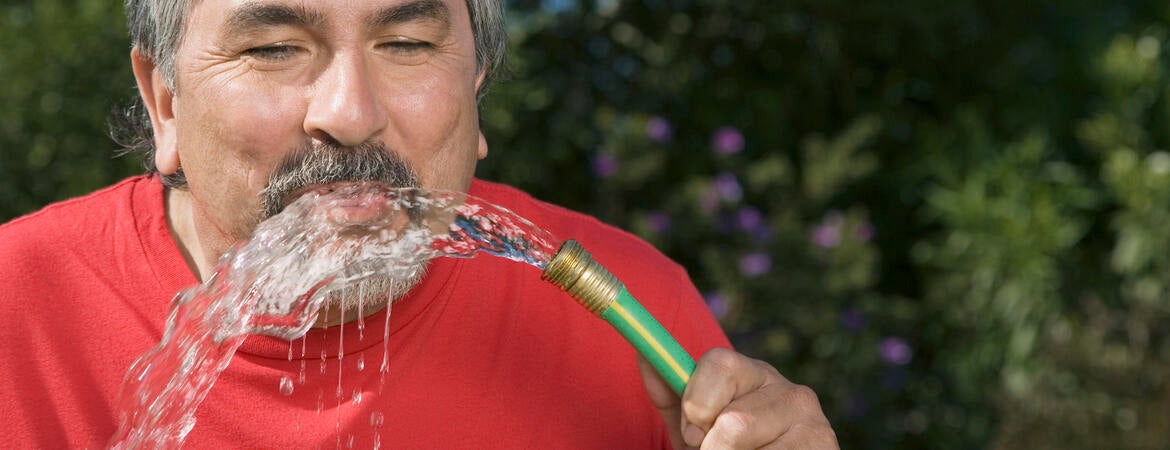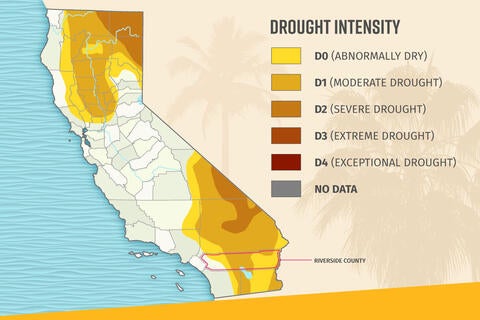
Headlines about California’s water situation are awash with numbers. Following the worst drought in 1,200 years, the Sierra Nevada snowpack, which provides 30% of the state’s water, is now among the biggest ones in 70 years. State reservoirs are at 73% capacity and more than half of CA is now officially out of drought. What to make of all these statistics?
Despite the welcome rainfall, the Colorado River, a key source of water for the state, is shrinking fast. Lake Mead and Lake Powell, which lie outside state borders, but hold a lot of the river water used in Southern California, are at less than 30%. Cities like Los Angeles receive around 50% of their water from the river. Intense negotiations are underway to decide how Western states will divide the reductions in water use needed to stabilize the river.
We asked a faculty expert on municipal water to help readers make sense of the seemingly conflicting headlines. Kurt Schwabe, UC Riverside professor of environmental economics and policy, does research on economic issues associated with water use, agricultural production, and urban water conservation. He was recently awarded a Fulbright Distinguished Chair Fellowship to collaborate with Australian scientists on better ways to capture and store water as the planet warms.
Q: With the recent rains and news of the record snowpack, can Californians finally stop worrying about water? Are we set for the foreseeable future?
A: People should recognize how much more quickly we can find ourselves in a very water stressed situation relative to what we've observed in the past. I think much of California felt they were very exposed and vulnerable to water shortages and shutoffs during the 1987 to 1992 drought. That experience led to Southern California making significant investments in storage such that we have 13 times more volume in storage in Southern California than we did back in the early 1990s.
Those were significant investments to help improve drought resilience. Yet, given our experience over the past three years with the extreme aridity, high temperatures, and significantly lower levels of runoff than we've ever observed previously, we need to adjust both our hard and our soft infrastructure that allow water to move over space and time in a more expeditious manner.
Q: What kinds of adjustments do you recommend for staving off dire water restrictions in the future, should the drought return?
A: Specifically, we need more investments in stormwater capture, conveyance, and storage so that we can hold onto the water from what are sure to be less frequent but more intense rainfall events. These events are also likely to result in much more intense runoff from accelerated melting of snow due to warmer temperatures.
We also need to ensure — and we can't start soon enough to sort this out — that the institutional structure e.g., rules and regulations, are developed so that such excess flows and runoff can be moved to areas where they can best provide resilience.
Q: How does our water situation now, in April 2023, compare to other times in our state’s history that also seemed extreme? What happens if we don’t make the adjustments you recommended above?
A: Up until this last storm, it's interesting how our situation in 2023 compared to that of 2019. Central Valley Project water, which is the main source for much of agriculture in the Central Valley, had initial allocations in 2019 of 35% based on assessed supplies. Two weeks ago, the project had also 35% initial allocations. Our largest surface water reservoirs had slightly more water in in 2019 then they did two weeks ago. And Lake Mead was 50 feet higher in 2019 than it was two weeks ago.
Of course, the snowpack in the Sierras is around 271% of historic average today, whereas in 2019 it was around 178%, which is a positive. But I'd say that we were in a better water supply position in 2019 than we are today, especially when you consider the Colorado and the lower volumes in Lake Mead and Lake Powell.
Thus, to your question about the consequences of not taking action today to better store water — you can see how in two to three years we can find ourselves again in a very precarious situation throughout the state given the new climate regime. So, while these past rains are great and put us in a much better situation than we were a month or two ago, I believe we have a long way to go before we can relax, and that will require a different level of funding, infrastructure investments, and collaboration than we currently have.
(Cover image: FangXiaNuo/iStock/Getty)




